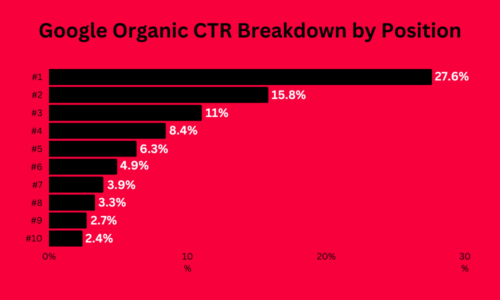What Constitutes Effective SEO First Website Design?
Olivia Jones May 26, 2023

SEO and website design are amongst the most important pillars when it comes to having a successful website, but every so often, there are cases where the two just aren’t in sync with one another.
When you have a website, there are two main aspects which you need to consider – website consumers and search engines. Typically, websites are designed to be seen but, whether you’re selling products or providing services, a nice-looking website isn’t enough for your business to be successful. Effective SEO website design is essential for your website to look good and bring sales or leads in.
At Red Cow Media, we understand the conflict that many of our clients have when it comes to finding the right balance between a website being both user friendly and SEO friendly. Typically, most businesses have two separate teams that focus on SEO and website design and achieving the balance to create an effective and SEO-first website design is something that some businesses struggle with.
Do you want to ensure your website is ranking for the most relevant terms, but does so in style? In this blog, we take a look at practices that can be implemented on your website, synchronising an effective SEO first web design.
What Is SEO Website Design?
SEO is the practice of optimising your website content so that it ranks well on search engines, whereas website design is the focus of the design and creation of a website and the pages on it. Combining the two for SEO first website design provides a well designed and functional website, which is optimised for search engines.
All too often, we find that SEO considerations have not been embedded within a website’s design during the planning stages. In the majority of cases, the consideration of SEO is only addressed once the site has launched, which can cause issues with some of the SEO fundamentals that are key to securing good rankings.
We advocate that SEO should play an integral role in the initial website design process, and believe that it should be considered from the very beginning of the planning stages. SEO and website design can work in harmony together, but usually, this is only when integrated together, as opposed to a thought later on.
Why Is SEO Website Design Important?
If your business website is well designed, looks good and is easy to navigate from a user perspective, but the pages aren’t ranking, then how exactly are organic users going to find your website? This is where SEO website design is important as a combination of both web design and SEO.
Whilst other channels, such as PPC or paid social media, are good for helping brand awareness and increasing traffic, as well as leads and sales, it is also important to focus on organic traffic. This is typically where the more qualified users find what it is they are searching for, whether it’s a dress for a certain occasion or a specific type of law firm.
In an ideal world, you want your most lucrative search terms and keywords for the different pages on your website to appear on the first page of search engines, within the first 9 ranking positions, as this is where the click-through rate is at its highest. In the graph below, you can see that the first ranking position gets over a quarter of all clicks, whilst the second gets just 15.8%. With the 10th result getting 2.4% of clicks, it’s clear to see those rankings past the second page will generate very few organic results, and the quality of user intent will decrease.

Although it’s important to go after the most lucrative keywords (these may also have the highest search volume), it’s important to also consider targeting a number of long tail keywords, as well as keywords with a lower search volume. This is because although these keywords may have lower search volumes, it also means that they could be more qualified as the term is more specific.
This, again, is where the importance of SEO first website design comes in. There are hundreds of different ranking factors, and a lot of these can be influenced or boosted by website performance, and vice versa with SEO. Organic SEO strategies can only get your keyword rankings so far, there also needs to be support from the website design and performance.
When these two factors are implemented early on in the website design process, it can bring results much sooner. When one is left to perform without the other, this is often when you can see keywords struggling to increase positions, as it needs the additional boost, whether from an organic SEO strategy, or an improvement in the website design.
What Constitutes Effective SEO First Website Design?
Knowing how to create a website which uses SEO website design is something that requires a good balance and understanding between the two. There are many different SEO best practices which factor into having an effective SEO first website design, whilst also giving users a better experience.
By having SEO practices built into the integral design of your website, you can then trust that you have a solid foundation from which search engines can recognise, granting better keyword ranking positions. SEO should be integrated within your website design as an iterative process, which is improved and updated over time. As mentioned, there are some essential factors that help to balance your SEO with your website design.
Quality User Content
Search engines are constantly searching for well-written, quality content that provides information for users. With Google’s more sophisticated guidelines, there is now a huge focus on having people-first content following the Helpful Content update in 2022. Although it is not an exact guide, Google now uses guidelines which evaluate content to help inform and build upon the Google algorithm. This algorithm, constantly learning and evolving, delivers users with the most relevant content related to their search query.
You ideally want your website design to be an engaging experience for website visitors, and a large part of this comes from creating high quality content for users, to provide an effective SEO first website design.
Use Headers To Create Content Hierarchy
When search engines are crawling your website, a lot of how they comprehend and understand your content is dependent on the structure that is in place. Google’s algorithm looks at the content hierarchy within a web page and prefers when there is a mixture of text and images in order to further understand your website’s content.
Headers are one type of web page design which helps to break down and further organise a page in a way which appeals to and benefits both the user experience and the SEO. Using the right header tags within your content means that the break up of text is more obvious to users on the front end who may be scanning through the content, however, it is also visible in the code of your website. The longer the content on a web page, the more opportunities there are to use heading tags. Adding heading tags to your content and website’s structure not only helps users to navigate your website content, but can also help search engines to understand your content.
Website Navigation
When it comes to web design, developers are typically focused on how the website looks overall and how the user interacts with the website. Web designers and developers will want to ensure that visual elements on the website look as good as they can and often this means keeping things as simple as possible. One area where this is usually the case is in the navigation menu of a website.
However, the website navigation menu is where there are crucial links to the most important product, service or feature pages. To ensure effective SEO website design, website navigation needs to be considered important.
- Use a content hierarchy – this helps to organise the pages on your website through the use of categories and subcategories. If you have numerous products, for example on an ecommerce website, then you should consider adding subcategories to your site in line with SEO website design.
- Internal links between pages – as part of an ongoing SEO content strategy, we focus on continually creating new and useful content in the form of blog posts, category content and new service or treatment pages. Adding internal links between these pages helps users to find useful and informative content, but also helps search engines to understand the connection between different pages on your site.
Site Speed
Your website speed is one of the factors that search engines, particularly Google, takes into consideration when ranking your website, becoming an important ranking factor back in 2018. Users don’t want to deal with a slow-loading website, so Google simply won’t show it to them if it doesn’t feel it necessary. This is an area where SEO and website design go hand in hand. When adopted early enough, the two can be combined to ensure that not only is a website fast loading, but users are seeing the content they want to see when the page loads.
Slow-loading websites have a higher bounce rate and stats show that around 42% of people will leave a site if it is slow loading or has poor functionality. Visitors expect fast-loading pages and if search engines identify that visitors aren’t finding what it is they are looking for, then this will result in lower rankings and poor website figures. By choosing to focus on how SEO and website design will combine with one another early on in the site build, you can work to improve the site and page speed, as well as look at other Core Web Vital factors.
URL Structure
Your website’s URL structure should be assembled around your SEO strategy. Each URL slug should, ideally, include your web page, post or product keyword. This is where there are often differences between SEO and website design. An SEO approach looks more at the importance of keyword rankings, whilst a design approach will consider the UX in more detail.
It’s important to factor in a mixture of the two approaches, but unlike some other factors we’ve looked at above, changing your website’s URL structure is something which can be done at any point within a strategy using redirects. However, it is best to do this at the beginning of a project. A URL structure helps search engines to understand what to rank your pages for, as well as how accessible your pages are.
Conclusion
The key to finding a balance between SEO and website design is to try and bridge the gap so often found between web development and SEO teams. It is important for both teams to work together to ensure a fully optimised website, from both an SEO and usability standpoint. At Red Cow Media, we understand that, at the end of the day, the important thing is to ensure your website provides you with an ROI and that your users are finding what it is they need.
Our teams have worked with numerous website design and development teams to ensure an effective SEO website design is in place. Whether from the very beginning of a project, or part way through, we can help provide feedback or conduct site audits as to where work should begin. To find out more about how we can improve your SEO website design, contact our team today!
